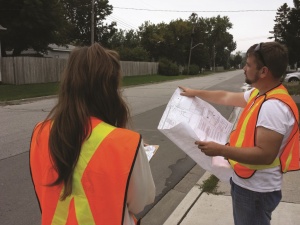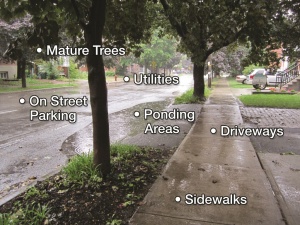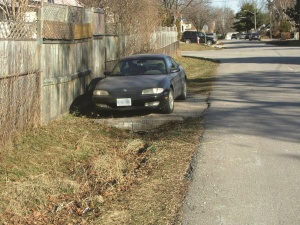Site conditions: road right of ways
It is critical that your project team understands site conditions for road right of ways (ROW) as part of the larger process of Screening LID Options. The choice of the ROW LID approach will depend on various site conditions that include road type, the type of construction project, and then various physical, social, and economic constraints.
Desktop Analysis of Background Documents[edit]
An initial desktop assessment of the site which includes various background studies, reports, and existing site plans will help have a larger understanding of the site, expected conditions, and what will need to be verified.
Field Reconnaissance of Site Conditions[edit]
Once complete, the next step is to assess site conditions in order to confirm your assessment, determine the technical feasibility of implementing LID practices within the municipal ROW, (i.e., the existing drainage conditions and general ROW characteristics), and identify and confirm any existing constraints. Pay attention also to the function of adjoining land uses and the activity that occurs in and around when noting site conditions for the ROW LID retrofit.
Site specific constraints, considerations, and conditions that can be identified during a field visit include:
- Road type
- Local residential road
- Residential collector road
- Local industrial road
- Industrial collector road
- Minor arterial road
- High density commercial road
- Type of road reconstruction.
|
|
The grinding of the base and top asphaltic compound to some nominal depth from the existing road surface and allowing for approximately 15-30% spot base repair where required while maintaining the original vertical design of the road.
May also include: • Repair or replacement of concrete curb and installation of sub-drains • Repair of concrete sidewalks • Adjustment and/or replacement of driveway aprons and sod |
|
|
Complete removal and replacement of the major ROW elements including the road base and asphalt surface, concrete curb, sidewalks, and can include reconstruction or replacement of the sub-surface infrastructure (hydro, gas, water main, sanitary and stormwater infrastructure).
Another type of road reconstruction can include the conversion of a rural cross section roadway into an urban cross section. This typically includes the installation of storm sewers, complete base and asphalt replacement, concrete curb placement, sub drains under curbs, and catch basin placement. |
|
|
As areas urbanize or infrastructure is upgraded rural cross section streets may be converted to an urban cross-section with curbs, gutters and storm sewers. Upgrades are one of the most common and economic opportunities in which LID can be incorporated into roads. |
|
|
A process in which the effective width or number of travel lanes contained in a crosssection is reduced in order to achieve system improvements. Roadway reductions can be used for traffic calming purposes, transit projects, alternative transportation strategies such as the interdiction of bicycle lanes, and pedestrian crossings. Through the process of roadway reduction, areas of the ROW that were used for vehicular travel are converted to sidewalks, landscaped boulevards, and/or cycle lanes. |
- Other conditions to note
- Local landscaping features and the landscape aesthetic of surrounding site area
- Overhead or underground utilities
- Utility lines not marked in the drawings
- Traffic patterns or safety concerns - how could the LID practice assist in traffic calming?
- Parking volume and location
- Encroachment issues – are there structures or features, such as fences, present?
- Paved boulevard areas
- Irregular surface drainage patterns, ponding, or lack of conveyance
- Adjoining land use – what activities are present that could impact ROW retrofit design, construction, or maintenance (i.e. excess garbage)?
- Use of the site – do residents use the ROW site to access other amenities, such as a transit shelter?
- Current maintenance practices within the ROW
- Are mature trees present? Could they impact construction, operations, and maintenance of the LID feature?
- Project support –property owners might choose to get involved in LID, but renters might not be inclined
Once you have collected the necessary site condition information, return to Screening LID Options


